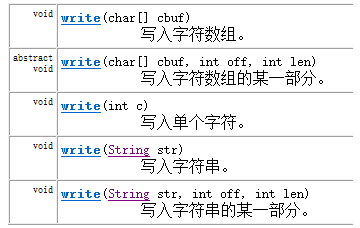字节输出流:
OutputStream此抽象类,是表示输出字节流的所有类的超类。以Stream结尾的都是输出字节流。
成员方法:

FileOutputStream类:
OutputStream有很多子类,其中子类FileOutputStream可用来写入数据到文件。FileOutputStream类,即文件输出流,是用于将数据写入 File的输出流。
构造方法:

public class Demo01 { public static void main(String[] args) throws IOException { //明确目的地 //如果目的地文件不存在,则会创建。 //如果目的地为文件存在,则会覆盖。 //new FileOutputStream("D:\io0803\demo10.txt",true); //(目的地地址,是否续写) FileOutputStream fos= new FileOutputStream("D:\io0803\demo10.txt",true); //写一个字节 fos.write(49); fos.write(48); fos.write(48); //写一个字节数组 byte[] bytes={-65,-66,-67,-68}; fos.write(bytes); //写字节数组中指定字节 fos.write(bytes, 1, 2); //换行 fos.write("你好吗 我很号".getBytes()); //释放资源 fos.close(); } }
处理异常:
public class Demo02 { public static void main(String[] args) { //明确目的地 //如果目的地文件不存在,则会创建。 //如果目的地为文件存在,则会覆盖。 //new FileOutputStream("D:\io0803\demo10.txt",true); //(目的地地址,是否续写) //写一个字节 FileOutputStream fos=null; try { fos= new FileOutputStream("D:\io0803\demo10.txt",true); fos.write(49); fos.write(48); fos.write(48); //写一个字节数组 byte[] bytes={-65,-66,-67,-68}; fos.write(bytes); //写字节数组中指定字节 fos.write(bytes, 1, 2); //换行 fos.write("你好吗 我很号".getBytes()); } catch (IOException e) { // TODO Auto-generated catch block e.printStackTrace(); }finally{ //释放资源 if(fos!=null){ try { fos.close(); } catch (IOException e) { // TODO Auto-generated catch block e.printStackTrace(); } } } } }
字节输入流:
InputStream此抽象类,是表示字节输入流的所有类的超类。
成员方法:

int read():读取一个字节并返回,没有字节返回-1.
int read(byte[]): 读取一定量的字节数,并存储到字节数组中,返回读取到的字节数。
FileInputStream类:
InputStream有很多子类,其中子类FileInputStream可用来读取文件内容。FileInputStream 从文件系统中的某个文件中获得输入字节。
构造方法:

成员方法:


public class Demo03 { public static void main(String[] args) throws IOException { //创建字节输入流对象,明确数据源(从哪读); FileInputStream fis= new FileInputStream("D:\io0803\demo10.txt"); //读一个字节 int len=0; while((len=fis.read())!=-1){ System.out.println((char)len); } //释放资源 fis.close(); } }
public static void main(String[] args) throws IOException { //创建字节输入流对象,明确数据源 FileInputStream fis= new FileInputStream("D:\io0803\demo10.txt"); //一个字节数组一个字节数组读 byte[] bytes=new byte[2]; int len=0; while((len=fis.read(bytes))!=-1){ System.out.println(new String(bytes,0,len)); } //释放资源 fis.close(); } }
一个字节一个字节的复制文件代码:
public class Demo05 { public static void main(String[] args) throws IOException { //明确数据源 FileInputStream fis= new FileInputStream("D:\io0803\demo10.txt"); //明确目的地 FileOutputStream fos= new FileOutputStream("D:\io0803\a\demo10.txt"); //开始复制(一个字节) int len=0; while((len=fis.read())!=-1){ //写一个字节 fos.write(len); } //释放资源 fis.close(); fos.close(); } }
一个数组一个数组的复制文件:
public class Demo06 { public static void main(String[] args) throws IOException { //明确数据源 FileInputStream fis= new FileInputStream("D:\io0803\demo10.txt"); //明确目的地 FileOutputStream fos= new FileOutputStream("D:\io0803\a\b\demo09.txt"); //开始复制(一个数组) byte bytes[]=new byte[1024]; int len=0; while((len=fis.read(bytes))!=-1){ fos.write(bytes,0,len); } //释放资源 fis.close(); fos.close(); } }
字符流:
字符编码表:
1:ascil码表:ASCII 码使用指定的 7 位或 8 位二进制数组合来表示 128 或 256 种可能的字符。标准 ASCII 码也叫基础ASCII码,使用 7 位二进制数来表示所有的大写和小写字母,数字 0 到 9、标点符号, 以及在美式英语中使用的特殊控制字符。其中:0~31及127(共33个)是控制字符或通信专用字符(其余为可显示字符),如控制符:LF(换行)、CR(回车)、FF(换页)、DEL(删除)、BS(退格)、BEL(振铃)等;通信专用字符:SOH(文头)、EOT(文尾)、ACK(确认)等;ASCII值为 8、9、10 和 13 分别转换为退格、制表、换行和回车字符。它们并没有特定的图形显示,但会依不同的应用程序,而对文本显示有不同的影响。32~126(共95个)是字符(32sp是空格),其中48~57为0到9十个阿拉伯数字; 65~90为26个大写英文字母,97~122号为26个小写英文字母,其余为一些标点符号、运算符号等。
2:iso-8859-1码表(拉代码表):是国际标准化组织内ISO/IEC 8859的第一个8位字符集。
3:GBK码表:目前最常用的中文码表,2万的中文和符号。用两个字节表示,其中的一部分文字,第一个字节开头是1,第二字节开头是0。
4:unicode码表:国际标准码表:无论是什么文字,都用两个字节存储。Java中的char类型用的就是这个码表。char c = 'a';占两个字节。 Java中的字符串是按照系统默认码表来解析的。简体中文版 字符串默认的码表是GBK。
5::基于unicode,一个字节就可以存储数据,不要用两个字节存储,而且这个码表更加的标准化,在每一个字节头加入了编码信息.
文字--->(数字) :编码。 “abc”.getBytes() byte[]
(数字)--->文字 : 解码。 byte[] b={97,98,99} new String(b,0,len)
字符输入流Reader:

read():读取单个字符并返回
read(char[]):将数据读取到数组中,并返回读取的个数。
FileReader类:
构造方法:

public class Demo01 { public static void main(String[] args) throws IOException { //创建字符输入流对象,明确数据源 FileReader fr=new FileReader("D:\io0803\demo03.txt"); //读一个字符 int len=0; while((len=fr.read())!=-1 ){ System.out.println((char)len); } fr.close(); } }
public class Demo02 { public static void main(String[] args) throws IOException { // TODO Auto-generated method stub //创建字符输入流对象,明确数据源 FileReader fr=new FileReader("D:\io0803\demo03.txt"); char[] ch=new char[1024]; int len=0; while((len=fr.read(ch))!=-1){ System.out.println(new String(ch,0,len)); } fr.close(); } }
字符输出流Writer类:

FileWriter类:
构造方法:

public class Demo03 { public static void main(String[] args) throws IOException { //创建字符输出流,明确目的地 FileWriter fw=new FileWriter("D:\io0803\demo04.txt"); //写入一个字符 fw.write(100); //字符需要写一下,刷一下 fw.flush(); //写入一个字符数组 char[] ch={'0','好','r'}; fw.write(ch); fw.write(ch,2,1); //写入字符串 fw.write(" 熊大"); //释放资源 fw.close(); } }
写入字符到文件中,先进行流的刷新,再进行流的关闭。
flush()和close()区别:

flush():将流中的缓冲区缓冲的数据刷新到目的地中,刷新后,流还可以继续使用。
close():关闭资源,但在关闭前会将缓冲区中的数据先刷新到目的地,否则丢失数据,然后在关闭流。流不可以使用。如果写入数据多,一定要一边写一边刷新,最后一次可以不刷新,由close完成刷新并关闭。
复制文本文件:
public class Demo04 { public static void main(String[] args) throws IOException { //明确数据源 FileReader fr=new FileReader("D:\io0803\demo03.txt"); //明确目的地 FileWriter fw=new FileWriter("D:\io0803\a\demo04.txt"); //开始复制,一个字符一个字符复制 int len=0; while((len=fr.read())!=-1){ fw.write(len); } //释放资源 fr.close(); fw.close(); } }
public class Demo05 { public static void main(String[] args) throws IOException { //明确数据源 FileReader fr=new FileReader("D:\io0803\demo03.txt"); //明确目的地 FileWriter fw=new FileWriter("D:\io0803\a\demo05.txt"); //开始复制,一个字符数组一个字符数组复制 int len=0; char[] chars=new char[1024]; while((len=fr.read(chars))!=-1){ fw.write(chars,0,len); fw.flush(); } //释放资源 fr.close(); fw.close(); } }